We love keeping up with the photos and videos from your fabulous bike tour!
Give us a follow on Instagram at @bikespaintours, and tag us in the posts from your trip.
Please leave your luggage in the hotel reception each morning (by 9am at the latest) so that it can be transferred to your next hotel. Make sure that your luggage is clearly labelled with the nametag provided. In case of any issues with the luggage transfer, please call Juan on (+34) 646 644 23 (Astorga – Portomarín) or Xacotrans on (+34) 608 581 206 (Portomarín – Santiago).
Your bike fitting is scheduled for Tuesday, 23rd April at 9am in the Parador de León. In case of any issues, please contact Enrique on (+34) 696 546 088.
Call the Bike Spain Tours office on +34 915 590 653, or out of office hours call +34 677 356 586. We will get you where you need to be and get you the help you need.
Please be aware that Spaniards follow a very particular routine in terms of their daily meals, and this is often strictly enforced by restaurant opening hours, especially in small towns!
You can expect restaurants to be open for lunch from approximately 1:30pm – 4pm. Many places will offer a menú del día: a set menu with 2/3 options for each course, usually including a drink, bread and dessert or coffee. Remember that lunch is the main meal of the day in Spain.
Dinnertime in Spain is any time from 8pm onwards. Dinner in Spain is typically a lighter meal.
In order to prove your status as a pilgrim (and be awarded your Compostela pilgrim certificate once you arrive in Santiago), you will need to obtain a credencial (pilgrim passport) at the start of your journey. In León, you can get your credencial from the Albergue del Monasterio de las Benedictinas (open daily 11am – 11pm) or from the Asociación de Amigos del Camino de Santiago (open Mon – Fri 11am – 1pm/6pm – 8pm). The credencial costs 2€, payable in cash.
Once you have your credencial, make sure that you get it stamped at least twice per day as you travel to Santiago. You can receive stamps in hotels, restaurants, churches, bars, cafés and many other places that you might visit along the way; we recommend that you try to get as many stamps as possible to turn your credencial into a unique souvenir of your trip!
Monday, 22nd April: Leon
Arrival day
Accommodation: Parador de León
Welcome to the Camino, and the start of an amazing tour!
Once you’ve checked into your accommodation, you will need to obtain your credencial (pilgrim passport) from the Albergue del Monasterio de las Benedictinas (open daily 11am – 11pm) or from the Asociación de Amigos del Camino de Santiago (open Mon – Fri 11am – 1pm/6pm – 8pm). The credencial costs 2€, payable in cash.
At leisure in León
Eating and drinking in León
No visit to León is complete without a tapas crawl around the Barrio Húmedo, or “wet district”, so called because it’s where you’ll find the highest concentration of bars and pubs! From the Cathedral, cross Calle Ancha, an ancient Roman road, and start exploring. You will receive a tapa with each drink order, so we suggest that you order cortos (small beers!)
Some of our favourite tapas bars are: La Bicha (for morcilla, or blood sausage), El Rebote (for croquetas), Jamón Jamón (charcuterie), Rúa 11 (150 varieties of vermouth), El Rincón del Gaucho (garlic soup).
Tuesday, 23rd April: Leon – Astorga
Route: 55km/34.6 mi
Elevation: +484m/+1,588 ft
Accommodation: Hotel Via de la Plata
Meals included: Breakfast
9am: Bike fitting at the Parador de León. In case of any issues, please contact Enrique on (+34) 696 546 088.
This first stage traverses classic Castilian landscapes, complete with holm oaks, golden wheat fields and moderate rolling hills. The straightforward route follows the path of the N120 highway. The scenery along the first half of the route is relatively dry, but gets greener the further west you go as the cornfields give way to endless vineyards. Keep your eyes peeled for geckos, birds of prey and dairy cows!
We recommend that you stop for lunch in the charming town of Hóspital de Órbigo, named after the pilgrim hospital founded by the Knights Hospitaller in the 16th century next to the Órbigo river. One of the town’s most famous attractions is the Paso Honroso, a 300m long stone medieval bridge, where according to the knight Don Suero de Quiñones once held a jousting tournament lasting over a month, in which he swore to break 300 lances in honour of unrequited love.
Our recommended lunch restaurant is La Encomienda (open daily 1pm – 4pm and Sat 1pm – 4pm/8pm – 12am), a historic spot whose specialty is trout.
Just before reaching Astorga, we recommend a quick photo stop at the Crucero de Santo Toribio, a stone cross atop a hill from where you can enjoy fabulous views of the Montes de León and Astorga.
At leisure in Astorga
Located at the convergence of the Camino de Santiago and the Vía de la Plata, Astorga offers a rich cultural legacy stretching from Roman times through to 20th century Modernism.
Eating and drinking in Astorga
A very traditional dish in Astorga is cocido maragato, a meat stew that is served one stage at a time: first the meat, then the vegetables, then finally the broth. What makes cocido maragato so special is that the rest of Spain serves their cocido in the reverse order, starting with the broth!
Cocido maragato is the perfect way to replenish calories after a long day of cycling, and we recommend you try it at Restaurante Casa Maragata, which is dedicated exclusively to this dish! They have two establishments in the city: Restaurante Casa Maragata I (open Wed – Sun 10:30am – 5pm) and Restaurante Casa Maragata II (open Fri – Tues from 10:30am – 5pm).
Wednesday, 24th April: Astorga – Villafranca
Route: 80.2 km/49.8 miles
Elevation: +1121 m/+3678 ft
Accommodation: Parador de Villafranca del Bierzo
From Astorga, the Camino climbs gently up to the foothills of your first mountain pass. Once you’ve reached the top of Foncebadón, relax and enjoy the sweeping downhill ride to Villafranca, with gorgeous views of vineyards stretching out endlessly on both sides.
At km 7, you’ll reach the picturesque town of Castrillo de los Polvazares, considered to be one of the region’s most beautiful examples of popular architecture. Take a quick breather to explore the cobblestone streets and admire brightly painted door and windowframes.
Further along the Camino, you’ll reach the medieval town of Rabanal del Camino, a historic pilgrim town where you can still find the remains of centuries-old pilgrim hospitals. For an authentic pilgrim experience, stop by the Municipal Pilgrim Hostel for a quick bite to eat at their bar/restaurant. On Sundays, they serve delicious plates of octupus! The town also houses the first monastery founded in the 21st century: the Monastery of San Salvador de Monte Irago.
Next, you’ll cycle up to beautiful mountain village of Foncebadón, which was largely abandoned until the mid-20th century, when the resurgence of the Camino started to attract new residents. If you’re passing through on a Saturday or Sunday, we recommend that you stop by La Taberna de Gaia (open Sat/Sun 12pm – 8pm), a unique medieval-themed restaurants serving authentic historical fare.
Just outside of Foncebadón, you’ll come across the famous Cruz del Ferro, the highest point of today’s ride and also the highest point of the Camino Francés, where pilgrims traditionally leave a small stone as a symbol of leaving behind their burdens before arriving in Santiago.
A little later, you’ll pass through the abandoned mountain village of Manjarín, where you can visit a pilgrim hostel founded by a modern-day Templar Knight! Tomás Martínez received the call to join the Order of the Knights Templar in 1993, and founded a medieval-style pilgrim hostel. Although the hostel is now closed, the site is still a fascinating insight into the history and spirit of the Camino.
Cross the medieval bridge into Molinaseca, and make a lunch stop at one of the riverside restaurants. Our favourites are Mesón El Palacio (open Fri – Wed 8am – 12am) and Mesón Puente Romano (open Thu – Tue 8am – 12am)
After Molinaseca, you’ll pass through the historic city of Ponferrada, historically a stronghold of the Knights Templar and still dominated by their imposing 12th century castle (open Tue – Sun 10am – 2pm/4pm – 6pm).
After Ponferrada, you’ll enter the region of El Bierzo, whose wines have their own Protected Denomination of Origin. You have plenty of opportunities to visit a local winery: on the way out of Camponaraya, you’ll find Viñas del Bierzo (open Mon – Fri 9am – 5pm and Sat 10am – 2pm), and Bodegas Godelia (open Mon – Fri 9am – 2pm/3pm – 6pm) and Losada Vinos de Finca (open Mon – Fri 9am – 2pm/3pm – 5pm) in Pieros.
At leisure in Villafranca del Bierzo
The town of Villafranca del Bierzo is was originally founded to provide pilgrims with refuge and sanctuary before beginning the most difficult part of their pilgrimage. The town boasts a long and storied history, and is replete with churches and monuments, testament to its importance as a stop on the ancient Camino de Santiago route.
Eating and drinking in Villafranca del Bierzo
Your hotel, has its own excellent restauarant serving locally-produced fare; however, if you would like to explore the town further, we recommend the Microhostal Restaurante La Puerta del Perdón (open Tue – Sun 1pm – 4pm), the restaurant at the pilgrim hostel Albergue Viña Femita, or Mesón Don Nacho (open Wed – Mon 8am -4pm/8pm-12am)
Thursday, 25th April: Villafranca – Portomarin
Route: 68.7 km OR 98.7 km/42.7 miles OR 61.5 miles
Elevation: +739 m OR +1814 m/+2425 ft OR +5,976 ft
Accommodation: Vistalegre Hotel Spa
Meals included: Breakfast
Get ready for the most challenging day of the Camino! From Villafranca the Camino climbs up to the mountain village of O’Cebreiro, the most demanding ascent of the western Camino Francés.
10am: In order to optimise your experience on this stage, we have organised for a taxi to collect you from your hotel and take you up to O’Cebreiro, so that you can spend the rest of the day enjoying the more beautiful (and flatter!) part of the ride.
The taxi will also take your luggage to Portomarín, so make sure you bring everything with you rather than leaving it in hotel reception.
The tiny mountain village of O’Cebreiro is your first stop in Galicia! The village holds huge cultural significance for the Camino de Santiago, and is well worth taking the time to explore. We highly recommend that you visit the pallozas: oval-shaped stone huts with straw roofs where for centuries local people cohabited with their livestock (open Tue – Sat 8:30am – 2:30pm in summer and 11am – 6pm in winter). Also worth a visit is the 9th century church of Santa María do Cebreiro (open Mon – Sat 9:30am – 1:30pm/4pm – 8pm and Sun 9:30am – 1:30pm), one of the oldest and best-preserved of the Camino, said to house the Holy Grail and whose bells once rang through the mists to guide pilgrims to safety.
Continuing on from O’Cebreiro, we highly recommend a stop at the tiny Albergue del Puerto, just beyond Padornelo, for a well-deserved slice of tortilla!
As you leave Triacastela, the Camino offers us two routes to Sarria. You’ll be taking the route via Samos, allowing you to visit the magnificent Monastery of Samos, which dates back to the 6th century. Samos is also known for its gastronomy, especially river fish such as trout and eel: you can try these at Hotel Veiga Restaurante (open daily from 8am).
The town of Sarria has reached legendary status on the Camino, because it’s the final town before the all-important 100km point, and therefore marks the starting point for many pilgrims. We recommend a quick stop here to soak up the Camino atmosphere, and grab some seafood from Restaurante Santiago.
Upon arrival in Portomarín, you’ll cross the Ponte Nova: the new bridge that was constructed in the 1960s following the flood that resulted from the construction of the Miño River. The older neighborhoods of the town once belonged to the Order of Saint John of Jerusalem, but now lie submerged. When the reservoir waters are low, it’s still possible to see the original medieval bridge and get an idea of the layout of the ancient town.
At leisure in Portomarín
The most important historical buildings of Portomarín were rescued, stone by stone, before the construction of the dam, and can still be seen today. Don’t miss the fortified Church of St Nicholas, and the Romanesque Church of San Pedro.
Eating and drinking in Portomarín
For a well-earned dinner, we recommend the riverside Restaurante O Mirador (open Sat – Thu, 1:30pm – 4:30pm/7:30pm – 10:30pm), which features a chill-out terrace with fabulous views, or Restaurante Xaones (open Sun – Fri 1:30pm – 11pm).
Friday, 26th April: Portomarín – Arzúa
Route: 58.3 km/36.2 miles
Elevation: +1052 m/3453 ft
Accommodation: Hotel Pazo Brandeso
Today’s stage marks a pleasant contrast with the exertions of yesterday! You’ll enjoy a relaxed ride across the rolling Galician countryside, gradually losing altitude.
Your ride today takes you to the Celtic heart of Galicia. As you leave Castromaior, you can take a short diversion to visit the Celtic castro (fortified town) which gave the town its name. Dating back to the 4th century BC, this castro is one of the largest Iron Age sites in the Iberian peninsula.
History-lovers might also consider a diversion of 9km round-trip to Castillo de Pambre, which dates back to the 14th century and is considered to be one of the finest examples of Galician medieval military architecture (open Apr – Oct: Tues – Sun 11am – 2pm/4pm – 6pm and Nov – Mar: Tues – Sun 12pm – 5pm=.
Further long the route, you will pass through the small town of Melide, famous for its speciality: pulpo a feira (Galician octopus!) You can sample this very traditional Galician dish at one of the town’s pulperías: Ezequiel (open daily from 9:30am) or A Garnacha (open dialy from 9:30am).
Eating and drinking in Arzúa
Arzúa is very famous for Arzúa-Ulloa cheese, which has Protected Denomination of Origin status. You can buy some to try at A Queixeira de Arzúa (open daily from 8am).
If you didn’t try pulpo at lunchtime in Melide, you can sample Galicia’s most famous delicacy at Pulpería Parrillada Europa (open daily from 9:30am).
Saturday, 27th April: Arzúa – Santiago de Compostela
Route: 44 km/27.4 miles
Elevation: +692 m/+2262 ft
Accommodation: Parador de Santiago
Today’s stage takes you along forest paths, through the beautiful Galician countryside to your final destination: the Pórtico de la Gloria (“The Façade of Glory”) of Santiago Cathedral!
Between the tiny hamlets of As Ras and A Brea, you’ll find Alimentos Ruta Xacobea (open Mon – Fri 10am – 1:30pm/4pm – 7pm), a small cheese factory making Arzúa-Ulloa cheese and other local varieties.
If you’d like to grab some lunch before arriving into Santiago de Compostela, we can recommend either Raxería San Marcos (open Wed – Mon 10am – 6pm) or Restaurante O Tangueiro for pulpo (open daily from 9am).
The official end-point of the Camino in Santiago de Compostela is the Cathedral, located in Plaza del Obradoiro. We recommend taking a break in the plaza to celebrate your achievement and soak up the amazing atmosphere. There is something indescribably human about the sight of hundreds of daily pilgrims arriving into the plaza, just as countless others have done over the centuries.
Inside the Cathedral, pilgrims traditionally embrace the statue of St James and visit his tomb. If you’d like to carry out this ritual, you can enter the Cathedral via Porta de Acibechería in Plaza da Inmaculada (daily from 8:30am – 9pm).
When you’re ready, you can visit the Pilgrim’s Office at Rúa das Carretas, 33 (open daily 10am – 6pm), where you can obtain the Compostela: the document certifying you as an official pilgrim! You can also request the Certificate of Distance, which reflects the start point of your pilgrimage, the number of kilometres travelled and the start and finish dates. This Certificate costs 3€, payable in cash at the Pilgrim Office.
Pilgrim’s Mass takes place in the Cathedral daily at 7:30am, 9:30am, 12:00pm and 7:30pm. At the beginning of the Pilgrim’s Mass, a list of the number of pilgrims who have been received in the Pilgrims’ Office in the last 24 hours is read out. Where they have travelled from and where they began their pilgrimage is also read out at the beginning of the service. If you’re lucky, you might even see the Botafumeiro, the enormous censer filled with incense and swung over the heads of mass attendees to counteract the smell of recently-arrived pilgrims!
Once you check into the Parador de Santiago, please leave your bikes with hotel reception for later collection.
At leisure in Santiago de Compostela
Santiago de Compostela was, without a doubt, the most important city in Christian medieval Spain. It’s world-renowned for its cultural and religious significance, and each year thousands of travellers come to visit.
Eating and drinking in Santiago de Compostela
Santiago de Compostela also has a fantastic tapas culture. You will receive one free tapa per drink purchased, so we recommend that you stick with small glasses of albariño wine! Some of our favourites are Bar La Tita (enormous portions of tortilla) Petiscos do Cordeal (seafood), Benboa (seafood), Viñoteca Ventosela (cheese and charcuterie), Raices Gallegas (traditional Galician dishes including zorza and raxo) and Orella (pig’s ear). We also recommend a visit to Casa Antonio, which serves wine in a traditional Galician cunca (bowl)!
Sunday, 28th April: End of tour
Departure Day
After breakfast, our tour will come to an end.
We hope you had a great time on your pilgrimage to Santiago de Compostela.
If you need any help with your onward plans, please feel free to contact our Bike Spain Tours team!
Parador de León GL San Marcos
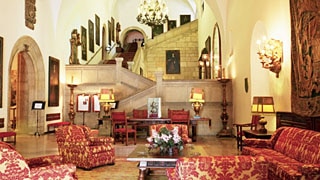
Located in Leon’s historical center, directly in the heart of one of the most impressive Roman complexes of the Peninsula.
The convent of San Marcos is one of the greatest architectural gems of the Spanish town of Leon, together with the Cathedral, the San Isidoro Basilica or the Casa Botines. It has now become a Parador and is one of the most important monuments of the Spanish Renaissance.
Hotel Via de la Plata
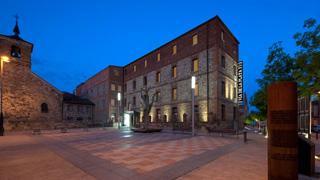
This modern hotel was built in 2011, over the stones of the convent of San Francisco.
The hotels design gave priority to the space in the rooms, the furniture and the welcoming contemporary decoration. If offers the rest you deserve while enjoying the best location in the historic district.
Parador de Villafranca del Bierzo
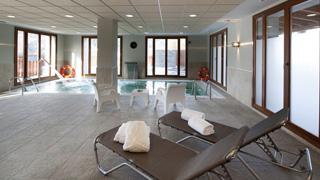
Villafranca del Bierzo is a town full of churches, monasteries and convents. Right at the town entrance stands this converted historical building, known as a Parador in Spain.
The leading tourist accommodation in the fascinating El Bierzo district. It is surrounded by mountains covered with cherry and fig trees, slopes dotted with chestnuts, poplars and small farms.
Vistalegre Hotel Spa
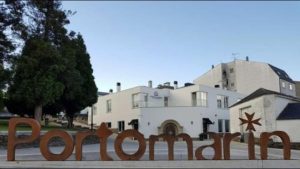
Recently renovated, Vistalegre Portomarín opened its doors in June 2018 to host guests who look for rest and relaxation.
This hotel offers free WiFi and views to the garden. Every room is equiped with flat TV screen, en-suite bathroom, A/C and a desk. They serve buffet breakfast.
Hotel Pazo Santa María
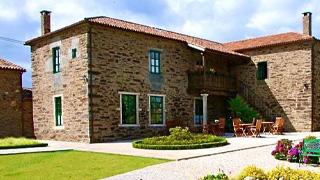
This elegant hotel dates back to the first half of the eighteenth century.
The Pazo Santa Maria complex comprises of various historical buildings which in themselves amount to a small village. Pazo Santa María has 16 lovely bedrooms located either in the main building or in the small individual annex cottages.
Parador de Santiago – Hostal Reis Catolicos
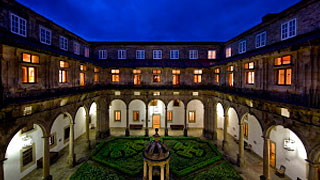
The Parador de Santiago is a blend of history, art and tradition. It is the emblem of the city and the prefect nights rest for pilgrims
The hotel is located in Obradoiro Square near the cathedral, creating an area of spectacular beauty in one of the most visited provincial capitals of the world. A stay at this Parador means a visit to a truly unique and exclusive location.
On a Bike Spain Tours vacation, understanding and abiding by the rules of safe cycling is vital.
You’re probably familiar with some common safety guidelines. Below are those that we follow at Bike Spain, and we ask that you follow them while traveling with us:
• Biking shorts
• Breathable, synthetic tops (short- and long-sleeved)
• Biking shoes
• Biking gloves and full-finger, wind-resistant gloves
• Helmets are mandatory!
• Wind & rain jacket
• Fleece jacket or warm vest/jacket
• Sunglasses
• Hat
• Bathing suit
• Sweater/jacket for cool evenings
• Walking shorts
• Comfortable walking shoes/sandals
• Evening wear
• Books about the area
• Travel alarm clock
• Camera
• First aid kit
• GPS
• Photocopies of your important documents
• Travel Insurance Certificate
• Airline tickets/Boarding Passes
• Passport/Visa (if required)
• Sunscreen and lip balm
• Required medications and their prescriptions
• Personal items and toiletries
• Mosquito repellent
• Expensive electronic items
• Expensive jewelry & family heirlooms
• Other valuables
Being on a bike tour shouldn’t mean constantly worrying about your bike breaking down. Nevertheless, bikes are machines, and issues can occur. Here’s what to look for if something doesn’t sound, feel, or work right.
ACCIDENTS: In case of an accident, keep calm, get off the road and go to a safe place (such as the hard shoulder) where you can evaluate the problem. If you suspect that you need medical care, call the Spanish emergency services on 112, explaining clearly where you are and what the problem is. Have your passport and your insurance documentation handy before calling. Please contact our office immediately after speaking with emergency services.
Remember that personal insurance it is not included on our self-guided tours. We offer an optional insurance policy. If you choose not to purchase this, please make sure that you keep own insurance documentation with you (including your passport).
The tour price does not include any roadside assistance with bicycle maintenance (e.g. flat tires) or any other taxi transfers during the tour. Any repairs that need to be caarried out on the bicycles that are not a result of negligence on Bike Spain Tours’ part will be paid for by the client.
HELMET: Cycling on the road in Spain without a helmet is illegal and unsafe; remember to wear your helmet at all times.
To check the weather before you leave on your trip, please take a look at current weather conditions at www.weatheronline.co.uk. For historical temperature and precipitation statistics visit www.weatherbase.com or take a look at the Spanish Meteorological website with detailed information per region (http://www.aemet.es/en/elclima/datosclimatologicos/valoresclimatologicos)
The history of Spain is a compendium of influences from the different cultures that have lived in the country. The first settlers on the Peninsula were the Celts and the Iberians. The Roman presence in Hispania lasted for seven centuries, during which time the basic borders of the Peninsula in relation to other European towns were set up. Many institutions were inherited from Rome such as the concept of family, Latin as a language, religion and law. At the start of the 5th century new settlers from the North arrived and settled on the Peninsula: the Visigoths in the interior and the Swabians on the West. The decomposition of the Visigoth state apparatus would lead to the successive infiltration of Arab and Berber troops from the other side of the Straits of Gibraltar at the beginning of the 8th century. In the middle of the 8th century the Muslims had completed occupation and Cordoba became the center of the flourishing Andalusian state. The Arab presence in Spain would last for almost seven centuries and leave an indelible mark on the Spanish cultural heritage.
Following a long period of peaceful coexistence, the small Christian strongholds in the North of the Peninsula took on a leading role in the Reconquest, which ended with the capture of Granada in 1492 under the reign of the Catholic King and Queen, traditionally considered the founders of peninsular unity and the imperial management of the Spanish revival. The 16th century represents the zenith of Spanish hegemony in the world, a process that would last until the middle of the 17th century. Following the death of Charles II, the last of the Austrians, who died without having had children, Phillip V inaugurated the dynasty of the Bourbons of Spain.
The crisis of the Old Order opened the doorway to the Napoleonic invasion. The War of Independence was a war against the French invasion, but also a revolutionary war due to the decisive involvement of the people and the clear formation of a national consciousness that would later shape the 1812 Constitution. The Courts of Cadiz thereby enacted one of the first Constitutions of the world which ratified that sovereignty would reside in the nation. The conflict between liberalists and absolutists, or in other words, between two different ways of perceiving the establishment of the state, would be one of the longest Spanish conflicts throughout the 19th century.
The ballot box is introduced into Spain and with it the first democratic experience of the 20th century: the second Republic, a brief attempt to introduce the reformations the country needed, frustrated by General Franco’s military rising and the outbreak of the Civil War in 1936. The military victory of General Franco gave way to a long dictatorial period that would last until 1975. Following his death, the Spanish peacefully made the transition from dictatorship to democracy in a process known as ‘the Spanish model’. Don Juan Carlos I, as King of the Spanish people, became the chief of a social and democratic state of law, which molded the Constitution of 1978.
More information…? Should you be interested in a specific theme, please check here, you will find many info about culture, environmental issues, nature, society, geography and politics.
In Spain you have exquisite and innovative dishes with the guarantee of internationally prestigious chefs. The highest quality products from the best producers, recipes combining popular tradition with artistic creation and offer you exciting, new flavors. Spain’s culinary revolution, headed by master chefs like Ferrán Adriá, Arzak and Berasategui turns the pleasure of good food into a luxury for the senses that is at its finest when savored in Spain.
Spanish cuisine is nowadays recommended in the finest restaurants, heralded by the most prestigious critics and demanded by millions of consumers over the world. It has gone through a real revolution, which, in the time of a few short years, has put Spain at the top of international cuisine. With traditional styles as the basis, a modern, innovative cuisine has developed, identified by the use of quality products and by the creativity of its chefs.
To read more about Spain’s cuisine
The Way of St. James or St. James’ Way (Spanish: El Camino de Santiago) is the pilgrimage route to the Cathedral of Santiago de Compostela in Galicia in north-western Spain, where tradition has it that the remains of the apostle Saint James are buried. The Camino has existed as a Christian pilgrimage for well over 1,000 years, and there is evidence of a pre-Christian route as well. Throughout the medieval period it was one of the three most important Christian pilgrimages undertaken. Indeed, it was only these pilgrimages—to Jerusalem, to Rome, and to Santiago de Compostela—which could result in a plenary indulgence, which frees a person from the penance due for sins.
The route was declared the first European Cultural Route by the Council of Europe in October 1987 and inscribed as one of UNESCO’s World Heritage Sites in 1993. Legend has it that the remains of the apostle James were brought to Galicia for burial. In 813, according to medieval legend, the light of a bright star guided a shepherd who was watching his flock at night to the burial site in Santiago de Compostela. The shepherd quickly reported his discovery to the bishop of Iria, Bishop Teodomiro. The bishop declared that the remains were those of the apostle James and immediately notified King Alfonso II in Oviedo. To honor St. James, the cathedral was built on the spot where his remains were said to have been found.
In the early 1980s only a few pilgrims a year arrived in Santiago. However, since the late 1980s the Way has attracted a growing number of modern-day pilgrims from all around the globe.
Most pilgrims carry a document called the credencial. The credencial is a pass which gives access to inexpensive, sometimes free, overnight accommodation in refugios along the trail. Also known as the “pilgrim’s passport”, the credencial is stamped with the official St. James stamp of each town or refugio at which the pilgrim has stayed. It provides walking pilgrims with a record of where they ate or slept, but also serves as proof to the Pilgrim’s Office in Santiago that the journey has been accomplished according to an official route. The credencial is available at pilgrim hostels, tourist offices, some local parish houses, and outside Spain, through the national St. James organisation of that country. The stamped credencial is also necessary if the pilgrim wants to obtain a Compostela, a certificate of completion of the pilgrimage.
The Compostela is a certificate of accomplishment given to pilgrims on completing the Way. To earn the Compostela, pilgrims need to walk a minimum of 100 km or cycle at least 200 km. The pilgrim passport is examined carefully for stamps and dates. If a key stamp is missing, or if the pilgrim does not claim a religious purpose for their pilgrimage, the Compostela may be refused.
The scallop shell, often found on the shores in Galicia, has long been the symbol of the Camino de Santiago. Over the centuries the scallop shell has taken on mythical, metaphorical and practical meanings. Two versions of the most common myth about the origin of the symbol concern the death of Saint James, who was killed in Jerusalem for his convictions.
–Version 1: After James’ death, his disciples shipped his body to the Iberian Peninsula to be buried in what is now Santiago. Off the coast of Spain a heavy storm hit the ship, and the body was lost to the ocean. After some time, however, the body washed ashore undamaged, covered in scallops.
-Version 2: After James’ death his body was mysteriously transported by a ship with no crew back to the Iberian Peninsula to be buried in what is now Santiago. As James’ ship approached land, a wedding was taking place on the shore. The young bridegroom was on horseback, and on seeing the ship approaching, his horse got spooked, and the horse and rider plunged into the sea. Through miraculous intervention, the horse and rider emerged from the water alive, covered in seashells.
The scallop shell also acts as a metaphor. The grooves in the shell, which come together at a single point, represent the various routes pilgrims travelled, eventually arriving at a single destination: the tomb of James in Santiago de Compostela. The scallop shell also served practical purposes for pilgrims on the Camino de Santiago. The shell was the right size for gathering water to drink or for eating out of as a makeshift bowl.
Today thousands of Christian pilgrims and non-Christian pilgrims each year set out from their homes or popular starting points across Europe, to make their way to Santiago de Compostela. Most travel by foot, some by bicycle, and a few travel as some of their medieval counterparts did, on horseback or by donkey. In addition to people undertaking a religious pilgrimage, the majority are travellers and hikers who walk the route for non-religious reasons: travel, sport, or simply the challenge of weeks of walking in a foreign land. Also, many consider the experience a spiritual adventure to get away from the bustle of modern life.
Info
About UsContact Info
Plaza de la Villa 1,
28005 Madrid
+34 915 590 653
info@bikespain.com
